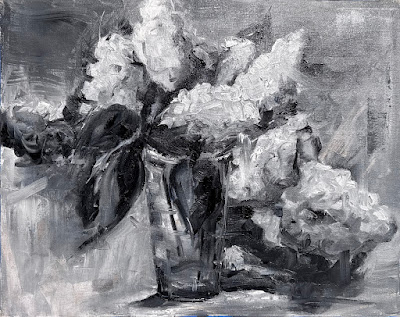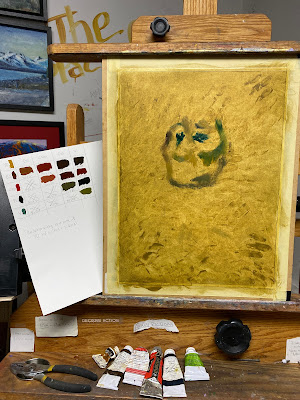 |
Hi Studio Journal readers!
Today I am writing about our 6th painting challenge. For those of you who saw the Juneau/Douglas City Museum December 2024 exhibit, you might be interested in seeing how these paintings came together.
Challenge #6 parameters (chosen out of a hat with 18 ideas)
1 - Blind contour* drawing to begin painting 2 - Collaborate with another member of our group and paint your work halfway through. Integrate your contributions so the original work can still be glimpsed. 3 - Rediscover an old successful painting or your own with the new parameters
First person responsibilities: After contour drawing, paint all of the big shapes of the painting. Within each shape, paint 50% of it, to what you consider to be “completed”. Leave the rest to the next artist.
Timi’s to Teri Teri’s to Patrick Patrick’s to Timi
|
So, I hope that is clear for those who
want to imagine what we did.
Here are the series of photos showing, first, my process
for finishing the painting that Timi gave me to work on.
(Remember, she did the blind contour,
from one of her own paintings, then painted it 50% of the way.)
The way Timi's painting looked when I took possession.
|
I got to work. I saw a cat.
Ok, here I was getting close, but realized that cats' legs
do not bend like that! ... so we had our cat
Haze Gray, model cat anatomy!
 |
Big Hat, Big Cat (sold)
oil on canvas
18 1/2" x 14 1/2"
by Timi Johnson
&
Teri Gardner Robus
|
Here is the original painting from which
Timi based her blind drawing and her half-way painting.
Next, if your patience is still holding, here are the photos of how my painting
progressed and how Patrick finished it.
 |
| my blind contour drawing |
 |
| This is my 50% finished - I handed it off to Patrick |
 |
Pear-fect Day
oil on panel
15" x 15"
by Teri Gardner Robus
&
Patrick Ripp
|
and my original painting:
 |
Perfect Fit
collage & oil on wood panel
12" x 12"
(available) |
| |
And last collaboration - Patrick & Timi collab.
This is his halfway through painting; handed on to Timi:
Finished painting by Timi
 |
Oils of Provence Reimagined
acrylic and oil on primed Dacron
24" x 24"
by Patrick Ripp
&
Timi Johnson
|
Here is Patrick's original painting.
This was a challenging challenge ... aren't they all?
Thank you for reading and check back for more posts about
our challenge paintings.
Thank you for your support!
happy painting/viewing/collecting!
Teri
*Blind contour drawing is a drawing exercise, when an artist draws the contour of a subject
without looking at the paper that they are drawing on.




































.jpg)















